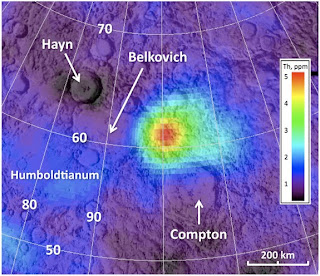
Shielded from Earth-bound eyes, the far side of the moon is home to a rare set of dormant volcanoes that changed the face of the lunar surface, a new study finds.
Data and photos from NASA's Lunar Reconnaissance Orbiter (LRO) reveal the presence of now-dead silicate volcanoes, not the more common basaltic volcanoes that litter the moon's surface, researchers said.
"Most of the volcanic activity on the moon was basaltic," primary author Brad Jolliff of Washington University told SPACE.com in an email. "Finding other volcanic types is interesting as it shows the geologic complexity and range of processes that operate on the moon, and how the moon's volcanism changed with time."
Because the moon's rotation has been affected by tidal forces between the Earth and the moon, only one side of the moon is visible from the Earth. The far side of the moon — sometimes referred to inaccurately as the "dark side" — was hidden from view until 1959, when Soviet Union's Luna 3 spacecraft took the first photos of the region.
When NASA's Lunar Prospector probe circled the moon in 1998, it revealed a highly reflective plain lying between two ancient impact craters. Known as the Compton-Belkovich region, this part of the moon contains thorium and other silicate rocks, suggesting a more involved type of volcanic activity than that which created the moon's well-known dark plains of basaltic plains known as "maria," or "seas."
Read More
Data and photos from NASA's Lunar Reconnaissance Orbiter (LRO) reveal the presence of now-dead silicate volcanoes, not the more common basaltic volcanoes that litter the moon's surface, researchers said.
"Most of the volcanic activity on the moon was basaltic," primary author Brad Jolliff of Washington University told SPACE.com in an email. "Finding other volcanic types is interesting as it shows the geologic complexity and range of processes that operate on the moon, and how the moon's volcanism changed with time."
Because the moon's rotation has been affected by tidal forces between the Earth and the moon, only one side of the moon is visible from the Earth. The far side of the moon — sometimes referred to inaccurately as the "dark side" — was hidden from view until 1959, when Soviet Union's Luna 3 spacecraft took the first photos of the region.
When NASA's Lunar Prospector probe circled the moon in 1998, it revealed a highly reflective plain lying between two ancient impact craters. Known as the Compton-Belkovich region, this part of the moon contains thorium and other silicate rocks, suggesting a more involved type of volcanic activity than that which created the moon's well-known dark plains of basaltic plains known as "maria," or "seas."
Read More
No comments:
Post a Comment